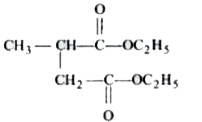In the given reaction
CH2−CH2−O∣∣C−CH2COOC2H5[X]−−→(A)(i)LiAlH4−−−−−−−−→(ii)H2O/H⊕CH3−CH2−O∣∣C−CH2−CH2OH+C2H5OH
[X] will be
HCHO
CH2OH∣CH2OH,H+
CH2OH∣CH2OH,OH−
HCN
The correct Answer is:B
To solve the given problem, we need to identify the reagent (X) that is used in the reaction to convert the starting compound into compound A, which is then subjected to further reactions with lithium aluminum hydride and dilute acid to yield the final products.
1. Analyze the Starting Compound:
The starting compound is CH2=CH2−C(=O)−CH2−COOC2H5. This compound contains a carbonyl group (C=O) and an ester functional group (COOC2H5).
2. Identify the Final Products:
The final products after treatment with lithium aluminum hydride and dilute acid are CH3−CH2−C(=O)−CH2−CH2OH and C2H5OH. The carbonyl group in the final product remains intact, indicating that it is protected during the reaction.
3. Understand the Role of (X):
Since the carbonyl group must remain unchanged while the ester is converted to alcohols, we need a reagent that can protect the carbonyl group.
4. Choose the Protecting Group:
A common method for protecting carbonyl groups is to use ethylene glycol in an acidic medium. This forms a cyclic acetal or a similar structure that protects the carbonyl group from reduction.
5. Write the Reaction with (X):
The reaction with ethylene glycol (HO-CH2-CH2-OH) in an acid medium will protect the carbonyl group. The reaction can be represented as:
\(
CH2=CH2-C(=O)-CH2-COOC2H5 + HO-CH2-CH2-OH \xrightarrow{H^+} \text{Protected Carbonyl}
\)
6. Reduction with Lithium Aluminum Hydride:
After protection, the compound is treated with lithium aluminum hydride (LiAlH4), which reduces the ester to two alcohols, while the carbonyl remains protected.
7. Acid Workup:
Finally, the protected carbonyl group is removed by hydrolysis with dilute acid, yielding the final products.
8. Conclusion:
Therefore, the reagent (X) that protects the carbonyl group during the reaction is ethylene glycol in an acid medium.
Final Answer:
The reagent (X) is ethylene glycol in acidic medium.
The starting compound is CH2=CH2−C(=O)−CH2−COOC2H5. This compound contains a carbonyl group (C=O) and an ester functional group (COOC2H5).
The final products after treatment with lithium aluminum hydride and dilute acid are CH3−CH2−C(=O)−CH2−CH2OH and C2H5OH. The carbonyl group in the final product remains intact, indicating that it is protected during the reaction.
Since the carbonyl group must remain unchanged while the ester is converted to alcohols, we need a reagent that can protect the carbonyl group.
A common method for protecting carbonyl groups is to use ethylene glycol in an acidic medium. This forms a cyclic acetal or a similar structure that protects the carbonyl group from reduction.
The reaction with ethylene glycol (HO-CH2-CH2-OH) in an acid medium will protect the carbonyl group. The reaction can be represented as:
\(
CH2=CH2-C(=O)-CH2-COOC2H5 + HO-CH2-CH2-OH \xrightarrow{H^+} \text{Protected Carbonyl}
\)
After protection, the compound is treated with lithium aluminum hydride (LiAlH4), which reduces the ester to two alcohols, while the carbonyl remains protected.
Finally, the protected carbonyl group is removed by hydrolysis with dilute acid, yielding the final products.
Therefore, the reagent (X) that protects the carbonyl group during the reaction is ethylene glycol in an acid medium.
The reagent (X) is ethylene glycol in acidic medium.
Similar Questions
Knowledge Check
CH3CH2CH2−O∣∣C−H+CH3−C≡ChNa,NH3(l)−−−−−−−→
A B
B C
C D
D
Find the product of following reaction
2CH_(3)CH_(2)-overset(O)overset(||)(C)-OC_(2)H_(5)underset(H_(3)^(o+)O)overset(C_(2)H_(5)overset(ϴ)(O))(to)(X)
X will beACH3−CH2−O∣∣C−CH∣CH3−O∣∣C−OC2H5BCH3−CH2−O∣∣C−CH∣∣CH3−O∣∣C−OC2H5C2CH3CH2−O∣∣C−OHD
H3C−CH2−O∣∣C−CH3ϴOD/D2−−−−→ Final product is
AH3C−CD2−O∣∣C−CH3BCH3−CH2−O∣∣C−CD3CD3C−CD2−O∣∣C−CD3DCH3−CD2−O∣∣C−CD3
CH3CH2−O∣∣C−O−C2H2(i)DIBAL.H(1eq)−−−−−−−−−−−−→(ii)H3O+A+B A and B are respectively.
View SolutionEnd product of this conversion
CH3−O∣∣C−CH2−CH2−CH2−CO2H1.NaBH4−−−−−−−→2.H2O,H+ is
View SolutionCH3OH+C2H5OHH⊕−−→ Products
View SolutionIn the given reaction C6H5−O∣∣C−CH3(i)C2H8MgBr−−−−−−−−→(ii)H2O/H+(X) X will be
View SolutionFind the last product [D] in reaction sequence
C6H5CHO+CH3−O∣∣C−CH2−COOC2H5 H3O+−−−→AΔ−−→CNH2−NH2−−−−−−→OH−/ΔD
View Solution
